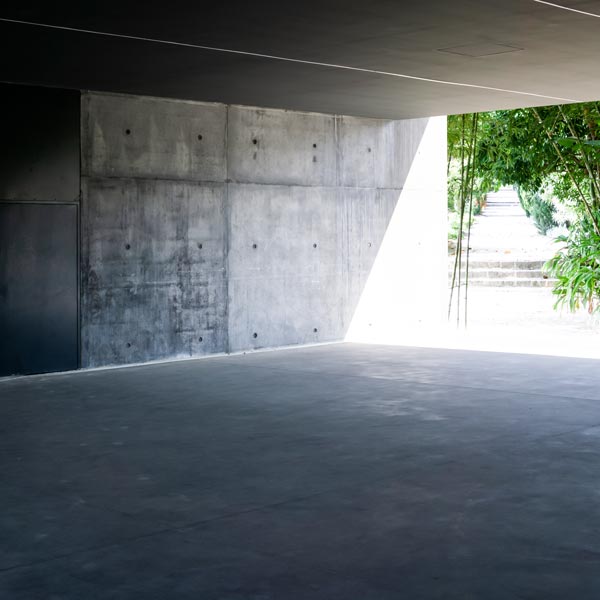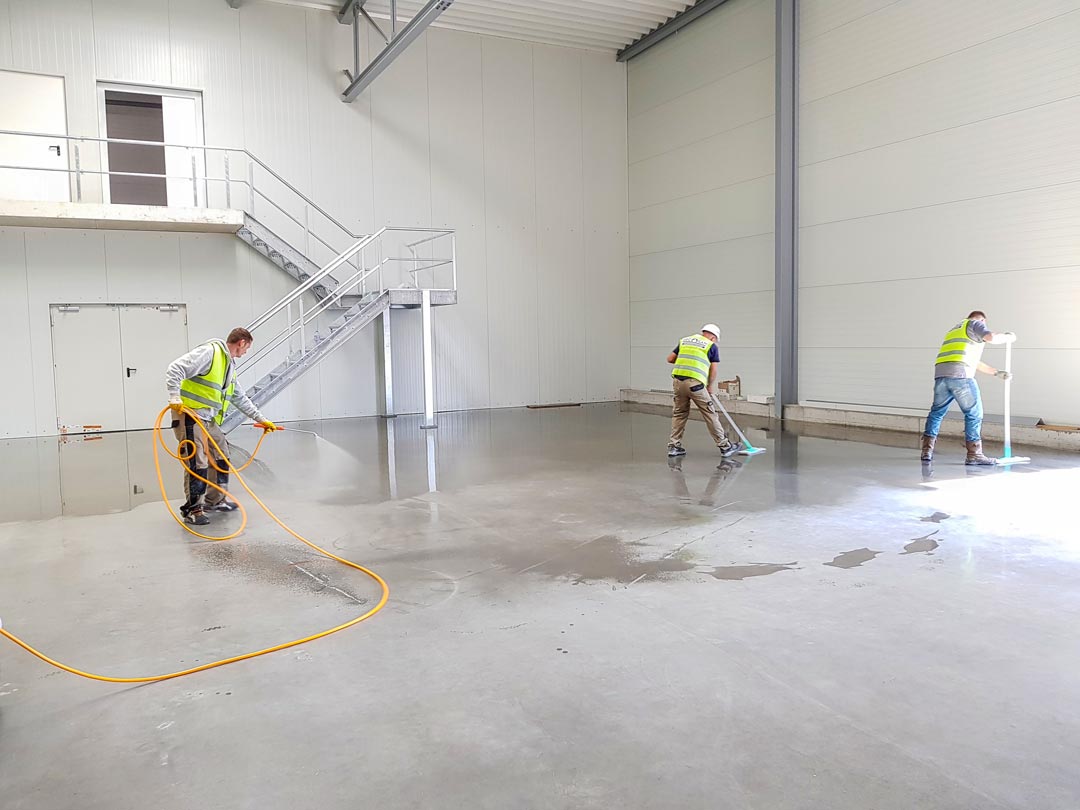How to polish concrete to get the best possible result
Polished concrete has a modern and sophisticated look. Thanks to the polishing process, it is possible to improve the performance of this building material. Any imperfections must be removed by grinding and polishing the surface until it is smooth, and blemishes are gone. Finally, the sealant is applied to minimize fluid absorption. The process is easy to understand, but it takes time and physical effort.
This post will discover all of the improvements that you can benefit from with a polished concrete floor. If you are looking for a polished concrete Chicago contractor, you came to the right place. At AM Facility Services we have been servicing concrete floors for over 20 years and have worked with customers from all walks of life. Don’t hesitate to call us: 1-800-956-3862 to discuss how we can help your with your next project.
What is Concrete Polishing?

Polishing concrete floors consists of using an abrasive segment tipped with industrial diamonds on rough concrete floors to get a smooth surface.
Think of it as shaving off microscopical amounts of the surface to remove any dirt, uneven surface, or other imperfections. Your floors can go from feeling rough to touch to be as smooth as glass.
Concrete can be polished dry or wet. At AM Facility Services, we favored wet polishing conditions to reduce dust; however, the concrete slurry is labor-intensive on its own. With our state of the art industrial vacuums, we have managed to keep the dust down to a minimum during our dry polishing processes.
Grinding-concrete
Our foreman would use a heavy-duty grinder with low grit metal bond diamond pucks or low grit diamond resin pucks for surface preparation. This is the cutting step where most of the shortcomings of the floors are being removed.
We then use the same type of grinder for polishing the concrete up. This process involves finer grit diamond resin concrete polishing pucks or pads.
The grinder could be a walk-behind, a ride-along, or a remote-controlled. The more advanced technology is behind the machine, the more pricey it will be.
A burnisher can also be used if paired with the right pads, but the project cannot involve any grinding.
The grinding segments that we use come in various sizes. The segment itself is usually a puck with a rough surface that is equipped with industrial diamonds. Industrial diamonds are widely used in grinding and polishing concrete floors. The size of the diamonds is reflected by the grit that the pucks are marked with.
The rougher the ground, the smaller the grit of the diamond pucks or pads will have to be used. For polishing a floor, we use larger grits with smaller diamonds such as 1500, 1800, or 3000 grit.
So in a traditional project, we start with a low grit and gradually increase it depending on the gloss level the customer wants.
Why should you polish your concrete floors?
A virgin concrete floor doesn’t have a very smooth surface. Instead, it has a semi-rough surface that might not be obvious to a naked eye. In order for your concrete floors to be ready for foot or machinery traffic, the floors need to be densified, closed off, polished, and sealed.
Polished concrete texture

It is very important that our floor polishing contractor service is completely carried out before the last step takes place. When we apply the concrete floor sealer, the floor has to feel smooth to the touch and already have a good gloss.
While the freshly laid concrete floor is going to be an easier floor to work with, an older floor might present quite a few challenges. Like everything new, new concrete floors require fewer steps to bring them to a presentable condition. Steps required for them to go from virgin concrete to completely polished concrete floors ready for use are pretty straight forward.
However, when you are dealing with older concrete, you will run into cracks, concrete chipping, screws, or pipes sticking out, maybe even some Quickrete fillings as well. At AM Facility Services, we pay close attention in order to recognize if the concrete isn’t too badly damaged. If it is cracked across the whole block, lifted, or sinking, it might require a full-on replacement of the blocks.
All of the issues with older concrete floors need to be resolved before the grinding and polishing processes take place. An inexperienced team might walk into the job site and get to work right away, which will lead to a lot of ongoing issues. It is better to have everything in order beforehand to save the customer and ourselves from many headaches.
Preparation of the concrete surface
Assessment of the concrete. The Mohs test is used for this, with which the hardness of minerals (concrete) is determined. This way, we can determine if it is a soft, medium, or hard concrete and fine-tune our polishing process.
With the tools provided, you can compare the hardness of concrete with the hardness of other minerals. If a pencil is able to scratch the concrete, its hardness on the floor corresponds to the next smaller number of pencils.
Clean the surface with an auto-scrubber, which should be filled with water. If you are working on a stubborn stain, you could also add neutral detergent to help you out with the process. We strongly advise against any acidic detergents on your concrete floors.
A stronger detergent may be required for particularly stubborn stains or mold. Hydrogen peroxide, ammonia, and phosphate cleaners (TSP) are good choices. However, these chemicals should not be mixed together. Select and use only one chemical and do proper research on what ratio to mix it with.
Before handling chemicals, wear gloves, eye shields, and protective gear while ensuring that the area is well ventilated.
Repair cracks or defects
Now is the time to repair any joints or floor damage. For concrete cracks, use a special concrete filler and follow the manufacturer’s instructions on how to mix it.
Allow the mix to dry completely before proceeding to the next step.
You can read up more about determining if your concrete needs a repair by reading our articles: Concrete Resurfacing or Concrete Repair, Which One Do You Need?
Grinding concrete with a low grit
A concrete grinder is a necessity for this step. Keep in mind that one of the key elements for a properly grinded concrete floor is the downward pressure of the grinder.
The grinders that we use are more than 1200lbs in weight and usually take two people to move or change out the grinding or polishing pucks. In addition, special grinding supplies must be used for grinding and polishing the concrete floor.
If you are doing this project on your own, you could possibly rent a grinder and order supplies from a reputable local distributor. That is the case if you could find a heavy enough grinder. However, if your project is of a larger scale, it is highly advised to research a concrete polishing contractor near me query.
Before operating the concrete grinding machine, a dust mask, gloves, protective goggles, and hearing protection must be worn. Keep in mind; safety always comes first!
If you chose to grind the floors dry, you must make sure that the industrial vacuums are working properly, hoses are connected well without any free play in the connections, and that the vacuum bags are safely secured.
Anti-slip steel toe boots are highly advised as part of the PPE. Gloves that will not easily let concrete dust and dirt seep through should be worn as well.
Grind the concrete with the lowest grit. If the floor has a lot of bumps or difficult stains, start with 15 grit; if it is in good condition, the grinding process can be started right away with 45 grit.
Lower grits indicate coarser grinding segments. In other words, 40 grit is coarser than 80 grit.
Follow the instructions that come with the grinder to correctly place the grinding segments. Drive the machine slowly over the entire concrete surface and work step by step from one corner to the diagonally opposite corner.
Gradually sand and polish the concrete floor, starting with the lowest grit and ending with the highest.
The strength of the required grain size varies depending on the hardness of the concrete.
Concrete sealing and finishing
Apply a thin layer of concrete sealer with an industrial microfiber mop. We usually use the 3M 18″ mops. Select a water-based (solvent-free) concrete sealer and follow the manufacturer’s instructions.
Usually, these concrete sealers are sprayed on the surface and spread out evenly with the microfiber mop mentioned earlier. You will need to wait until the sealer is completely dry before stepping onto the floors.
Sealing grinded concrete floors

Concrete sealers protect the concrete floors from grease, dirt, and stains getting inside of the floor. Besides the protective properties of sealers, the floor will also have a higher gloss and extended durability.
How much sealer to put down on the floor will depend on what the instructions say on the container. Manufacturers of the sealers are very specific in telling you how much is the right amount. You must keep in mind that each floor will absorb different sealants differently.
Apply in a single layer. It is important that the sealant is spread with a microfiber mop to avoid puddling. You should give the sealer proper time to heal before continuing to the next step.
Polish the surface again with the finishing pad. A high-speed polisher and diamond pads are required for this step. Work slowly and evenly and work the entire surface at an even pace.
Move-in the opposite direction in which the sealant was applied.
When finished, the floor will be smooth and shiny, with almost a mirror-like finish. The feel of the completed, polished concrete floor will not be much different from touching the glass surface.
The sealant must be completely dry before the concrete floor can be actively used. The drying time varies depending on the manufacturer and the ventilation and location conditions.
Dry or wet polishing?
There are two ways to polish a floor: wet and dry. While wet polishing lowers the chance of having to deal with dust issues, the cleanup costs become pretty noticeable.
We mostly use dry concrete grinding, unless specifically requested by the customer to go with the wet process. In order to deal with dust issues, a vacuum cleaner is connected to the grinding machine, which sucks off the resulting dust. All modern grinding machines are equipped with suction connections.
When we are working with a wet grinding and polishing process, water is sprayed on the floor in the areas that are being grinded. Wet grinding and polishing make cutting the floors faster due to reduced heat; however, the cleanup cost is higher than dry grinding and polishing.
Of course, wet polishing creates mud and cement dust, which must be carefully removed and disposed into special containers. Another thing to keep in mind is that concrete mud cannot be left to sit on the floor for extended periods of time. In fact, it should be getting cleaned up off the floor right away.
Different types of polished concrete floor finishes
There are three standard versions of AM Facility Services: matte, mid-range gloss, and high gloss. Each of these surface finish variations has a different process and a different amount of steps that we take.
The floors must be scrubbed very well in-between each of the steps. The scrubbing machine of our choice is Tennant 5680, which we have been using for over a decade on our projects.
Right after the grinding process but before concrete polishing, we apply a densifier to harden the concrete and make the floors more durable in the long run.
After the last step of our concrete polishing services process is complete, we apply a concrete sealant, which minimizes the liquid absorption and increases the gloss of the floor.
The final step is slow to burnish off the floors with a high-speed concrete floor burnisher with a 3000 grit pad.
Concrete sludge is a toxic and highly alkaline substance that must be disposed of carefully. The difference between a real concrete professional and an irresponsible company is an obligation to dispose of sludge in an environmentally sound manner. At AM Facility Services, we take this topic very seriously and work in three steps.
Separate and neutralize
The concrete slurry is removed from the customer’s site, and AM Facility Services separator is added to the mix. This converts the pH value of a highly alkaline suspension into a pH-neutral value.
The separator also enables the separation of reusable, clean water from the sludge. This can be safely drained away, while the non-alkaline, condensed sludge remains.
At AM Facility Services we strive to protect the environment with any project that we take part in.
Solidifying
By adding a solidifier makes sure that the concrete slurry is solidified and ready for removal. Once solid the substance can then be placed in containers that will be transported out of the job site.
Transportation
Once the concrete slurry is solid, it can be transported out of the job site into an authority approved disposal site.
How much do concrete polishing contractors charge?

Not one answer can be given to answer this question since it depends on a lot of factors.
First, we need to take into account the quality and especially the hardness of the concrete that is present. As odd as this may sound, soft concrete is more difficult and more expensive to polish as many problems can arise, and more supplies will get used.
The surface is rougher, which means more abrasives are used. Therefore the surface must be well prepared before treatment.
We have to take into account the degree of damage to the concrete floor: how many screws to remove from the floor, how many cracks have appeared, how much is the floor marked with paint and tire marks, how badly is the floor stained?
We also need to consider the size of the concrete floor. The larger and wider it is, the more efficient the grinding process can be. The rule of thumb is the larger the area of the project; the cheaper the rate per square foot will get.
The location of the project has to be taken into consideration, as well. How far is it from where the concrete polishing contractors are based out of? Is access easy for machines and sludge containers? Are there any approved disposal sites nearby?
What type of finish would you like for your polished concrete floors? Will you want a mirror-like finish? Maybe you are satisfied with a matte finish? Both of these finishes will require a different amount of steps to take and will vary in the usage of resources.
With that in mind, we estimate that the cost of creating a polished, premium, long-life concrete floor in 2020 will be anywhere from $2-$10 per square foot.
AM Facility Services has been a concrete polishing contractor for fortune 500 companies. With over 20 years of experience in the floor care industry and highly skilled technicians, we can guarantee you great results.
No project is too big or too small for us. AM Facility Services concrete polishing company is proudly servicing Chicago and all of Illinois, Indiana, Ohio, Michigan, and Kentucky. Remember that if you need to contact a polished concrete company, we can help.
AM Facility Services only works with top of the line equipment and supplies to guarantee the quality of its surfaces. Call now to discuss how we can help you with your project: 1-800-956-3862
